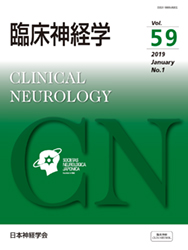Volume 59, Issue 7
Displaying 1-16 of 16 articles from this issue
- |<
- <
- 1
- >
- >|
Original Articles
-
2019 Volume 59 Issue 7 Pages 399-404
Published: 2019
Released on J-STAGE: July 31, 2019
Advance online publication: June 27, 2019Download PDF (645K) -
2019 Volume 59 Issue 7 Pages 405-411
Published: 2019
Released on J-STAGE: July 31, 2019
Advance online publication: June 27, 2019Download PDF (655K)
Case Reports
-
2019 Volume 59 Issue 7 Pages 412-417
Published: 2019
Released on J-STAGE: July 31, 2019
Advance online publication: June 27, 2019Download PDF (1062K) -
2019 Volume 59 Issue 7 Pages 418-424
Published: 2019
Released on J-STAGE: July 31, 2019
Advance online publication: June 27, 2019Download PDF (947K) -
2019 Volume 59 Issue 7 Pages 425-430
Published: 2019
Released on J-STAGE: July 31, 2019
Advance online publication: June 27, 2019Download PDF (1364K) -
A case of anti-titin antibody positive nivolumab-related necrotizing myopathy with myasthenia gravis2019 Volume 59 Issue 7 Pages 431-435
Published: 2019
Released on J-STAGE: July 31, 2019
Advance online publication: June 27, 2019Download PDF (1035K) -
2019 Volume 59 Issue 7 Pages 436-441
Published: 2019
Released on J-STAGE: July 31, 2019
Advance online publication: June 27, 2019Download PDF (2015K) -
2019 Volume 59 Issue 7 Pages 442-447
Published: 2019
Released on J-STAGE: July 31, 2019
Advance online publication: June 27, 2019Download PDF (1467K)
Brief Clinical Notes
-
2019 Volume 59 Issue 7 Pages 448-450
Published: 2019
Released on J-STAGE: July 31, 2019
Advance online publication: June 27, 2019Download PDF (346K)
Proceedings of the Regional Meeting
-
2019 Volume 59 Issue 7 Pages 451-453
Published: 2019
Released on J-STAGE: July 31, 2019
Download PDF (382K) -
2019 Volume 59 Issue 7 Pages 454-460
Published: 2019
Released on J-STAGE: July 31, 2019
Download PDF (1519K) -
2019 Volume 59 Issue 7 Pages 461-473
Published: 2019
Released on J-STAGE: July 31, 2019
Download PDF (2671K) -
2019 Volume 59 Issue 7 Pages 474-479
Published: 2019
Released on J-STAGE: July 31, 2019
Download PDF (1136K)
Notice
-
2019 Volume 59 Issue 7 Pages 480-483
Published: 2019
Released on J-STAGE: July 31, 2019
Download PDF (335K) -
2019 Volume 59 Issue 7 Pages 484-489
Published: 2019
Released on J-STAGE: July 31, 2019
Download PDF (271K)
Editor’s Note
-
2019 Volume 59 Issue 7 Pages 490
Published: 2019
Released on J-STAGE: July 31, 2019
Download PDF (137K)
- |<
- <
- 1
- >
- >|
